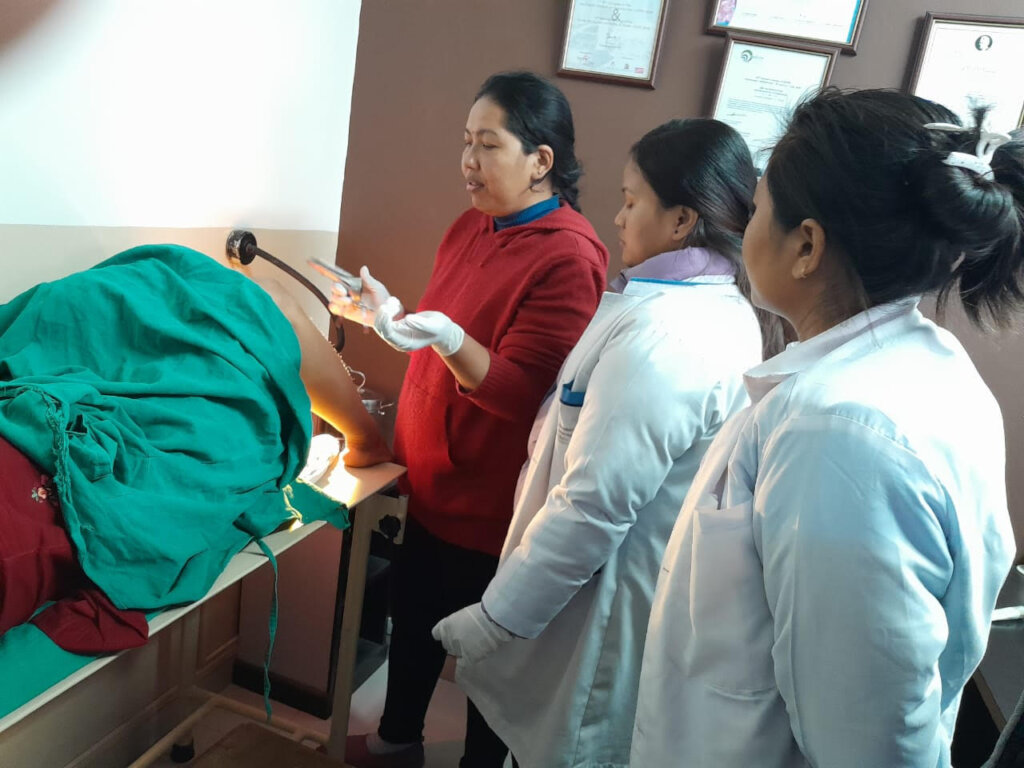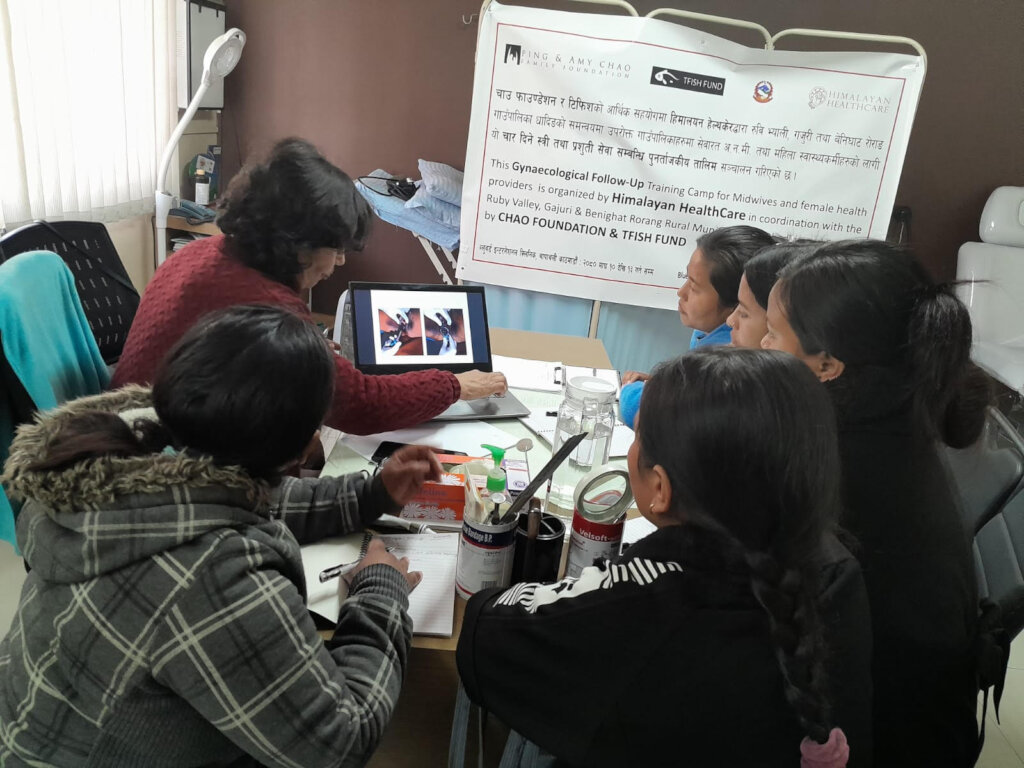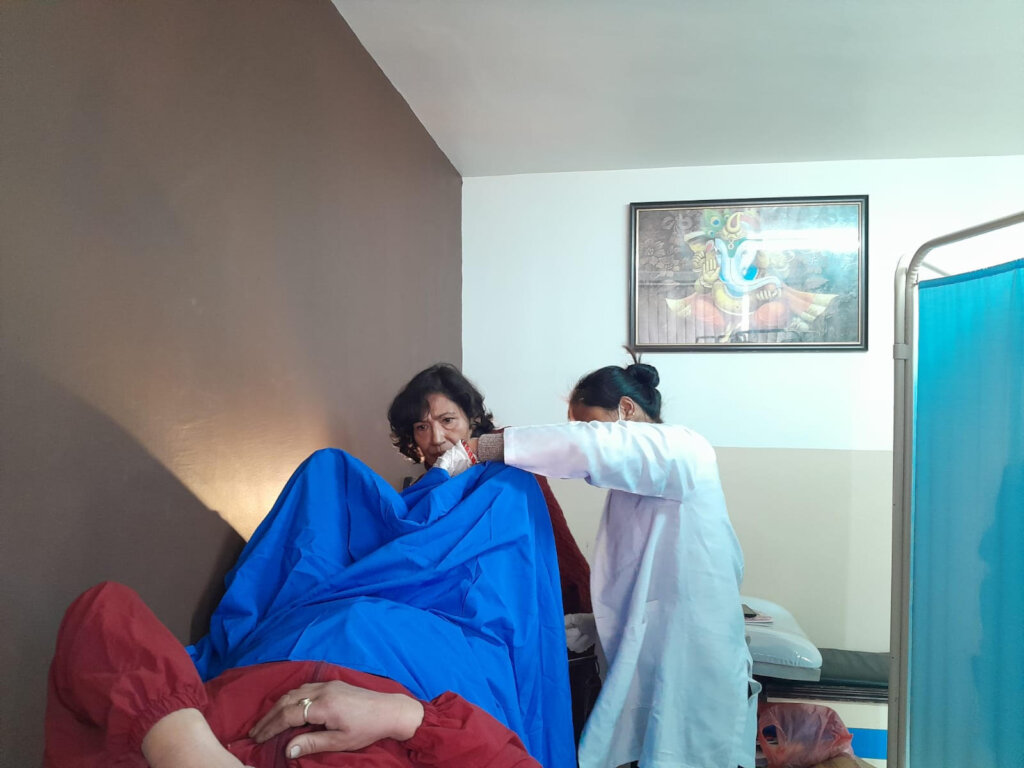By Soni KC | Project Leader
Date: 24 to 27 January 2024
Venue: Bluebird International Clinic, Thapathali, Kathmandu
Participants: 10 ANMs from Ruby Valley, Benighatrorang, Gajuri and Siddhalekh Rural Municipalities
Trainers: Drs. Madhu T & Madhu S
Funded by: Chao Foundation & T Fish Fund
Implemented by: Himalayan HealthCare Nepal
Day 1 Training (24 Jan):
Physical Examination
GC (general condition): fair, ill looking, conscious or unconscious,
Vitals: T, PR, RR, BP (temperature, pulse, respiratory rate & blood pressure)
PILCCOD: (pallor, icteric, cyanosis, clubbing, edema, dehydration)
Chest examination: B/L normal vesicular breath sound and equal air entry, crepitation and wheeze
CVS (cardiovascular system): s1 s2 or any added sound
A/P (per abdomen): any mass feel and tender
P/S (per speculum): polyp, discharge, erosion on cervix and its position
P/V per vaginal: feel any cyst or mass and motion tenderness on cervix
Breast examination: standing and hands-on waist, press by palm on the breast as quarterly on both breasts.
Vaginal Discharge & Types:
Sexual infected- TV, Chlamydia, Gonorrhea, Syphilis, HSV
Non sexual infected- BV, Candida (mostly below 25 Year
Foreign body, atrophic (dryness) and malignant
Day 2 Training (25 Jan 2024)
Ectopic Pregnancy:
It also called extra-uterine pregnancy or when a fertilized egg grows outside of the uterus (90% in fallopian tube). As the pregnancy grows, it can cause the tube to burst (rupture) and can cause major internal bleeding.
Early warning of ectopic pregnancy:
Often, the first warning signs of an ectopic pregnancy are light vaginal bleeding and pelvic pain. If blood leaks from the fallopian tube, you may feel shoulder pain or an urge to have a bowel movement. Your specific symptoms depend on where the blood collects and which nerves are irritated.
Treatment for ectopic pregnancy:
The most common drug used to treat ectopic pregnancy is methotrexate. This drug stops cells from growing, which ends the pregnancy. The pregnancy then is absorbed by the body over 4–6 weeks.
Pelvic Organ Prolapse (POP):
Descent of one or more of the genital organs below their normal anatomical position. Prolapse is a condition in which organs, which are normally supported by the pelvic floor, namely the bladder, bowel and uterus, herniate or protrude into the vagina due to weakness in their supporting structures.
Cause:
Pelvic organ prolapse happens when the muscles or connective tissues of the pelvis do not work as they should. The most common risk factors are: Vaginal childbirth, which can stretch and strain the pelvic floor. Multiple vaginal childbirths raise your risk for pelvic organ prolapse later in life.
The four categories of uterine prolapse are:
Symptoms of pelvic organ prolapse (POP):
Treatment of pelvic organ prolapse:
Any surgical procedure may pose risks or create complications, nonsurgical procedures are usually the first line of treatment for POP.
Nonsurgical treatments
Surgical treatments
Surgery may be an option if your symptoms haven’t improved with conservative treatments and if you no longer wish to have children.
Pelvic Floor Exercises
Demonstration of pelvic floor exercises were carried out by the expert at the Bluebird International Clinic.
Day 3 Training (26 Jan 2024)
Dysfunctional Uterine Bleeding (DUB):
Itis a condition that affects nearly every woman at some point in her life. Also called abnormal uterine bleeding, DUB is a condition that causes vaginal bleeding to occur outside of the regular menstrual cycle. Certain hormonal conditions and medications may also trigger DUB. The main cause of dysfunctional uterine bleeding is the imbalance in the sex hormones.
Signs: Anemia, abdomino-pelvic examination is usually normal. If uterus is enlarged, fibroids are likely
Symptoms: Heavy or prolonged vaginal bleeding, dysmenorrhea (on/off); pelvic pain or uncomfortable pressure
Investigation: Pregnancy test, CBC, TFT, USG
Management: Tranexamic and Mefenamic acid are useful to decrease loss during periods, oral contraceptive pill to regulate irregular cycle
Menorrhagia (more than 80 ml) is very common among age below 45 years
How is DUB diagnosed:
The diagnosis of DUB depends on a thorough history and physical examination to exclude organic disorders. In older women, endometrial biopsy should be done before starting therapy. The treatment depends on an understanding of the menstrual cycle.
Complications of chronic abnormal uterine bleeding can include anemia, infertility, and endometrial cancer. Acute abnormal uterine bleeding, severe anemia, hypotension, shock, and even death may result if prompt treatment and supportive care are not initiated.
Cervical Cancer
It is one of the most common genital cancer among Nepalese women, number one among all the cancer reported in Nepal and has a high morbidity and mortality rate. It affects women at a relatively younger age. Cervical cancer has a very long pre-cancerous condition (10 to 20 years) & detection during pre-cancerous condition is possible by screening; and the condition is curable by simple treatment.
VIA (visual inspection with acetic acid):
Screening carcinoma of cervix with simple technic is called VIA. This is the technic applicable in all level of health institutions.
Acidic acid with normal saline applies around the cervix and leave for a minute then observe the color.
Result: Color changes if positive and no changes if negative.
Also, Pap smear, LBC (liquid bases cytology), HPV DNA tests are conducted
Signs and Symptoms:
Asymptomatic:
Almost all cases of cervical cancer are caused by persistent infection with some high-risk types of the Human Papilloma Virus; this is the biggest risk factor for cervical cancer. The other main risk factor for cervical cancer is smoking. Around eight out of 10 women will become infected with genital HPV at some time in their lives. Most women who have the HPV infection never get cervical cancer; only a few types of the HPV result in cervical cancer.
Management:
Preventive: HPV vaccine and awareness to predisposing factors, chemotherapy, radiotherapy and surgery
Day 4 Training (27 Jan 2024)
Postpartum Hemorrhage (PPH):
Postpartum hemorrhage (PPH) being the major cause of women death in Nepal, the participants were taught on how to manage PPH
Definition: An estimated blood loss of >500ml of blood from the genital tract at vaginal delivery & >1000 ml at caesarean section or 1500 ml at caesarean hysterectomy.
Classification: 1. Primary: within the first 24 hours after delivery 2. Secondary: when it occurs between 24 hours to 6-12 weeks postpartum
Causes: 4Ts (tone 80%, trauma, tissue and thrombin)
The principles of management: ABC- Airway, breathing & circulation; Replace circulating blood volume & Stop blood loss; Medical management: Oxytocin, Ergometrine, Carboprost and Misoprostol; Non-medical management: Uterine massage, Bimanual uterine compression, Compression of aorta against sacral promontory, Anti-shock garment and Intra uterine pressure
The Condom Balloon Tamponade
Condom Foley's catheter tamponade is simple, easy to use and is believed to give effective results. This technic is applicable in any health institutions. It is simple and does not require expertise to use it, so it can have wide application even in resource poor settings.
Briefing: Trainers informed in detail about materials and instruments to be prepared prior to the procedure, importance of condom tamponade and technic of procedure.
Demonstration: Trainers demonstrated how to set up, technic of procedure and possible errors by using artificial uterus.
Practical: After the demonstration, all participants were asked to show the set up procedure as taught by the trainers.
Amenorrhea:
Amenorrhea is defined as the absence of menstruation during the reproductive years of a woman's life. Physiological states of amenorrhea are seen, most commonly during pregnancy and lactation (breastfeeding). It can be classified as primary and secondary amenorrhea
There are two types of amenorrhea:
Cause- physiological and pathological
Treatment- of amenorrhea depends on the underlying cause and various tests such as pregnancy test, thyroid function test, ovary function test, prolactin test and male hormone tests can be conducted. In some cases, birth control pills or other hormone therapies can help. If caused by thyroid disorder, it can be treated with medications.
Dilation and Curettage Instrument Sets and Uses (D & C)
A dilation and curettage, also called a D & C or D and C, is a minor surgery that involves dilating or opening the cervix. The cervix is the opening to your uterus or womb. After dilating your cervix, your doctor uses a spoon-shaped object called a curette to remove tissue from the inner lining of your uterus. D&C may help diagnose or treat growths such as fibroids, polyps, hormonal imbalances, or uterine cancer. A sample of uterine tissue is viewed under a microscope to check for abnormal cells.
Instruments in D &C Set:
Set of 14 instruments- hegar dilator set of 8, sims speculum, sponge holder, vasculum, uterine sound, wall depressor and uterine curette.
After this session, there was a discussion regarding the problems the participants were facing on their work place. Review of the topics of previous days and post questions discussions were carried out. The closing program was done in the presence of hospital director and matron of the Sahid Memorial Hospital.The trainees were also handed out handprints and training material at the end of the training.
The clinical demonstration of examination being important, the trainers were able to demonstrate the examination in out-patient department (OPD). All together 17 patients were practically examined by the health providers under the guidance of the trainers.
Overall, it was a productive training and the participants were very eager to learn and to practice the knowledge & learnings in their respective health posts.
By Soni KC | Project Leader
By Soni KC | Project Leader
Project reports on GlobalGiving are posted directly to globalgiving.org by Project Leaders as they are completed, generally every 3-4 months. To protect the integrity of these documents, GlobalGiving does not alter them; therefore you may find some language or formatting issues.
If you donate to this project or have donated to this project, you can recieve an email when this project posts a report. You can also subscribe for reports without donating.
Support this important cause by creating a personalized fundraising page.
Start a Fundraiser

